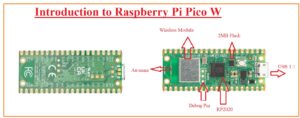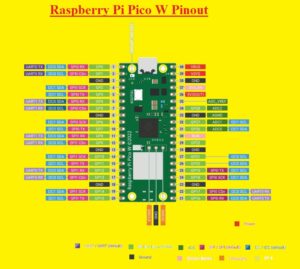 Hello, readers welcome to the new post. today we will discuss Introduction to Raspberry Pi Pico W. The Raspberry Pi has introduced its first WIFI based controller of Raspberry PI PICO that is named as Raspberry Pi Pico W. Here W denotes wireless. This board has less power than the Raspberry PI 4 model but has the same features and operates the basic programs and controls different other components connect to it. It was created with RP2040 SOC which is a high-speed controller board and also has a dual ARM cortex-MO+ processor. That is ARM Processor
Hello, readers welcome to the new post. today we will discuss Introduction to Raspberry Pi Pico W. The Raspberry Pi has introduced its first WIFI based controller of Raspberry PI PICO that is named as Raspberry Pi Pico W. Here W denotes wireless. This board has less power than the Raspberry PI 4 model but has the same features and operates the basic programs and controls different other components connect to it. It was created with RP2040 SOC which is a high-speed controller board and also has a dual ARM cortex-MO+ processor. That is ARM Processor
In this post will cover its basis different parameters pinout and some other features. So let’s get started
Introduction to Raspberry Pi Pico W
- Raspberry PI Pico W is the first wireless microcontroller of Raspberry pi that was manufactured for the computing process. It is considered as the Raspberry PI PICO successor.
- it is also built on the Raspberry foundation with ARM processor CHIP 2040. The basic advantage of this module is WIFI and Bluetooth technology introduced in it
- It has very less outer circuit configurations to be compatible to RP2040, flash memory unit, power supply, USB connector.
- RP2040 pinouts are exits left and right edge of the board. There are 4 RP2040 inputs and output configured for external operations LED operation, SMPS.
- It comes on board 2.4GHZ wireless interfacing with the use of Infineon CYW43439. its onboard antenna is licensed from ABROACON.
- Its wireless interfacing is done through use of SPI communication with RP2040
- Its configuration is compatible to a 0.1-inch pin header.

Raspberry Pi Pico W Features
- Its main features are discussed here
- This module comes with an RP2040 controller
- It has a two MB flash memory unit
- It has single band 2.4 gigahertz wireless interfacing
- Its micro USB port B is used for power connection in data transmission
- it comes in forty pinout configuration and dual in-line packaging of 21mm by 51mm
- It has two SPI, Two I2C, two UART, and three twelve-bit ADC
- It also consists of sixteen PWM channels
- It has a temperature sensor
- it has three pinouts for the ARM serial debugging process
- its structure of power supply is flexible
- Its larger stock is available and has high quality and fewer prices
- It has two sixty-four KB static RAM
- It has a USB 1.1 Host
- Its power sleep and dormant modes are low
Raspberry Pi Pico W Pinout
- Raspberry Pi Pico W Pinout is discussed here
- It comes with forty pinouts like older PICO boards twenty-six pins are used as general purpose input and output pins
- These twenty pins denote GP0 and GP1. GP2 to GP28.GPIO pins operate at 3.3 volts with these pins this module has three-pin header debug interfacing that is positioned to RP2040
- GPIO23: It is Op wirelles power on
- GPIO24: here SPI data is provided
- GPIO25: OP wireless SPI CS – when high also enables GPIO29 ADC pin to read VSYS
- GPIO29: OP/IP wireless SPI CLK/ADC mode (ADC3) to measure VSYS/3
- WL-GPIO0: It regulates the outer connect LED
- WL-GPIO1: It regulates the SMPS power saver pin existing on board
- WL-GPIO2: For VBUS sensing – high if VBUS is present, else low

How to program the Pi Pico W?
- The programming languages supported by the PI PICO W are listed here
- C/C++
- MicroPython
- Thonny IDE
- Arduino IDE
How to power Pi Pico W?
- For providing the power to the Pico W USB port or VSYS pinout can be used
- The basic technique to power the PICO W is to connect a USB port of five volts with that VSYS pin can be used that is linked to the battery. These volts are then converted into 3.3 volts through the use of a voltage regulator
Difference between Raspberry Pi Pico and Raspberry Pi Pico W
- The basic difference between these to controllers is that there is no existence of CYW43439 2.4-GHz Wi-Fi chip that is used for wifi and Bluetooth
- There is the use of RT6154A in the new version while in PI PICO RT6150B was used
- In new pi PICO debug port exists close to SoC for making the area for the wifi antenna
Raspberry Pi Pico W Operating Conditions
- Its maximum operating temperature is seventy centigrade
- The minimum operating temperature is muns twenty
- VBUS 5V ± 10%.
- VSYS Min 1.8V
- VSYS Max 5.5V
How to Program the Raspberry Pi Pico W Flash
- The two MB QSPI flash memory of this board can be programmed through the use of a serial wire debug port with USB can be used
- The easy way to program this memory is in USB mode. For this operation off the power of the board after that hold the BOOTSEL button to power up the board.
- PICO W will show as a USB mass storage module. Through moving the uf2 file on the disk will write this file to flash and restart the PICO module
That is all about the Raspberry Pi Pico W all details has explained if you have further questions ask them here


